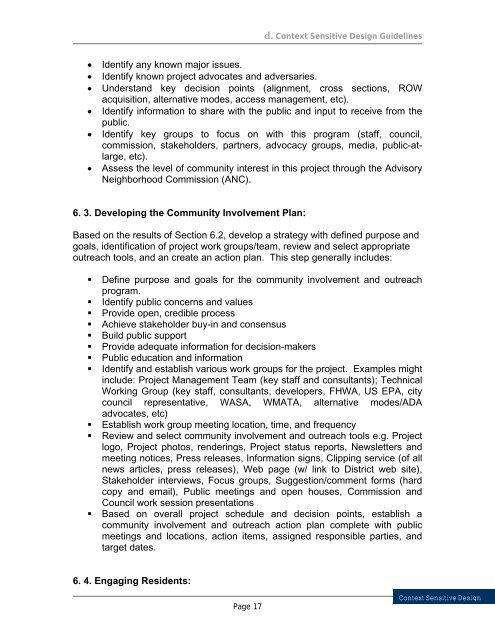Context Sensitive Design Guidelines - sacog
Context Sensitive Design Guidelines - sacog
Context Sensitive Design Guidelines - sacog
Create successful ePaper yourself
Turn your PDF publications into a flip-book with our unique Google optimized e-Paper software.
d. <strong>Context</strong> <strong>Sensitive</strong> <strong>Design</strong> <strong>Guidelines</strong><br />
• Identify any known major issues.<br />
• Identify known project advocates and adversaries.<br />
• Understand key decision points (alignment, cross sections, ROW<br />
acquisition, alternative modes, access management, etc).<br />
• Identify information to share with the public and input to receive from the<br />
public.<br />
• Identify key groups to focus on with this program (staff, council,<br />
commission, stakeholders, partners, advocacy groups, media, public-atlarge,<br />
etc).<br />
• Assess the level of community interest in this project through the Advisory<br />
Neighborhood Commission (ANC).<br />
6. 3. Developing the Community Involvement Plan:<br />
Based on the results of Section 6.2, develop a strategy with defined purpose and<br />
goals, identification of project work groups/team, review and select appropriate<br />
outreach tools, and an create an action plan. This step generally includes:<br />
• Define purpose and goals for the community involvement and outreach<br />
program.<br />
• Identify public concerns and values<br />
• Provide open, credible process<br />
• Achieve stakeholder buy-in and consensus<br />
• Build public support<br />
• Provide adequate information for decision-makers<br />
• Public education and information<br />
• Identify and establish various work groups for the project. Examples might<br />
include: Project Management Team (key staff and consultants); Technical<br />
Working Group (key staff, consultants, developers, FHWA, US EPA, city<br />
council representative, WASA, WMATA, alternative modes/ADA<br />
advocates, etc)<br />
• Establish work group meeting location, time, and frequency<br />
• Review and select community involvement and outreach tools e.g. Project<br />
logo, Project photos, renderings, Project status reports, Newsletters and<br />
meeting notices, Press releases, Information signs, Clipping service (of all<br />
news articles, press releases), Web page (w/ link to District web site),<br />
Stakeholder interviews, Focus groups, Suggestion/comment forms (hard<br />
copy and email), Public meetings and open houses, Commission and<br />
Council work session presentations<br />
• Based on overall project schedule and decision points, establish a<br />
community involvement and outreach action plan complete with public<br />
meetings and locations, action items, assigned responsible parties, and<br />
target dates.<br />
6. 4. Engaging Residents:<br />
Page 17<br />
<strong>Context</strong> <strong>Sensitive</strong> <strong>Design</strong>
















